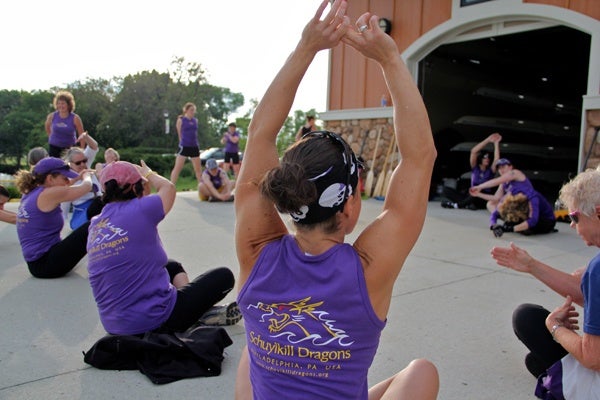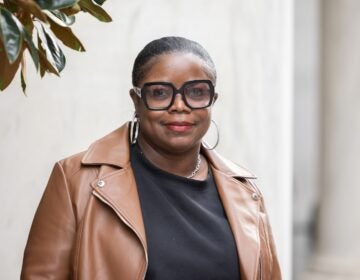Woodmere’s juried exhibit features local up-and-coming artists
Every spring, Woodmere Art Museum takes what director and CEO William Valerio calls, in this year’s show catalog, “a step into the abyss.”
In other words, Woodmere staff gives the reins to an outside artist – or in this case, two – to mount the museum’s annual juried exhibition.
This year, under the title “In Front of Strangers, I Sing,” jurors Dona Nelson and Rubens Ghenov selected works from about 50 artists from a group of 600 entrants.
Sand, silk, and Mylar
As with any open-call juried show, Nelson emphasized that many young and emerging artists are represented. But the show also includes work by several established artists, and a few pieces from the jurors themselves.
Woodmere staffers agree that this show is a departure from the museum’s usual offerings with mediums that range from traditional painting to Mylar, silk, a thrift-store Afghan, sand, discarded neighborhood signage and motorized papier-mache.
A city of young artists
“We feel there’s so much going on in the younger crowd,” said Woodmere deputy director of exhibitions Sally Larson.
Nelson and Ghenov agree that the Philadelphia’s young artists – many of whom, after graduating from the city’s arts institutions, choose affordable studios in neighborhoods like Fishtown, Kensington and Port Richmond instead of departing for New York City – have something special to offer.
The two jurors met in the late 90s when Ghenov was Nelson’s BFA student at Tyler School of Art. Now they are both professors at the school, a role that keeps them in touch with the local emerging artists’ scene.
Larson noted that in the past, Woodmere has often invited jurors from institutions outside Philadelphia, but this year, the museum decided to go with jurors who “know the terrain” of the city’s up-and-coming artists.
Inside the collaboration
Both Nelson and Ghenov say that their differences, both personal and artistic, were crucial to their jury process.
“We’re friends, but we’re really different,” Nelson said. With nearly 30 years between them (Nelson was born in 1947, Ghenov in 1975), age is one factor, but their experiences vary widely as well. Nelson received her undergraduate degree in Ohio and has split her time between New York City and the Philadelphia area since then. Ghenov, who currently lives in South Jersey, was born in São Paolo, Brazil and came to the U.S. in 1989. He went on to graduate from Tyler, and received his MFA in painting from the Rhode Island School of Design.
“A lot of times we agreed, but not always,” Nelson said of jurying the flood of submissions in an upper room at Woodmere.
Nelson, whose large-scale abstract expressionist paintings occupy collections at Woodmere, the Guggenheim Mueseum and the Metropolitan Museum of Art, among others, described her work as very rough and physical in its process, while Ghenov’s work is “very tight [and] intellectual”.
Ghenov, whose contributions to the show include spray paint and acrylic works on linen and wood echoed this sensibility when describing the jurors’ approach.
To him, developing the show was an “algorithm” with four parts: the uncontrollable variable of the submitted work, the curatorial process of selecting the pieces, Nelson’s perspective, and his own.
“A lot of people say, ‘please disagree with me and tell me exactly what’s on your mind,’ and they don’t really mean it,” he continued. “I really appreciate it being completely open [and] finding a unique voice in between her own voice and my voice.”
Abstract or real?
Nelson said that ultimately the show’s themes included the interplay of art and photography, including the ways photography can blur lines between reality and artistic abstraction in what she calls “the everyday abstract.”
“If you go out and look at a splash of water on the asphalt – is that abstract, or is that real? So what is abstraction now?”
According to Nelson, Ghenov developed “art as it exists in the home” as another major theme, exploring the intimate ways the art we choose for our own walls reflects our homes and ourselves.
On the walls
Frank Bramblett’s “Accomplished,” a 13-year odyssey of the artist’s real-life to-do lists gathered in a white, black and yellow collage that solidly covers an entire wall of the exhibition, is an engaging example of how art can intersect with everyday life.
Also on display is Timothy Belknap’s “Tin Box,” an inscrutable black-and-white papier-mache figure that stands a few feet high. An old man’s long arms and large feet dangle on marionette-like strings that enable one foot to rhythmically stamp its pedestal whenever a viewer passes its motion-activated motor.
Other works include Jacque Liu’s “Tiggeriffic,” a 3-D work of brilliant white and orange stripes, and Sarah Roche’s “Thunderstorm Seaside Park,” in which a wild, earthy sky seems to weep into the green ocean.
Poetic curators
Nelson noted that it all adds up to an “accessible” show that still conveys “sophisticated art-world ideas.”
Ghenov added that many juried exhibitions, versus ones curated from an existing collection, “end up being the best of the pool” without necessarily having a “cohesive” theme. He noted that he and Nelson worked hard to develop a “silent poetic structure” in the Woodmere galleries.
“In Front of Strangers, I Sing: the 72nd Annual Juried Exhibition” at the Woodmere Art Muesum is open to the public from May 25 to September 1, with an open house on Saturday, June 1 from noon to 4 p.m. Visitors are also invited to a free gallery tour and wine and cheese reception (advance registration suggested) with jurors Dona Nelson and Rubens Ghenov on Saturday, June 8.
WHYY is your source for fact-based, in-depth journalism and information. As a nonprofit organization, we rely on financial support from readers like you. Please give today.
















